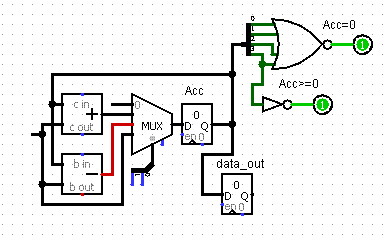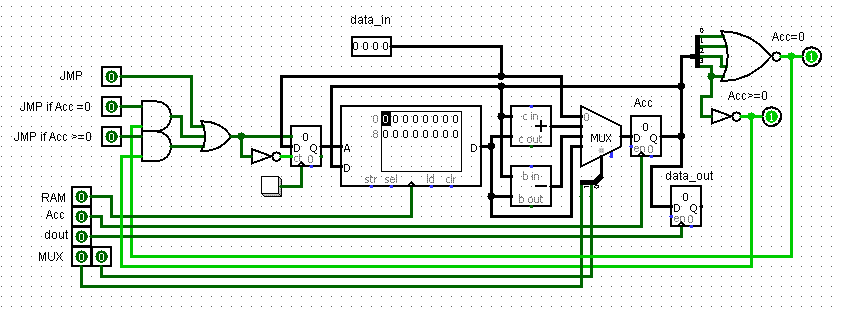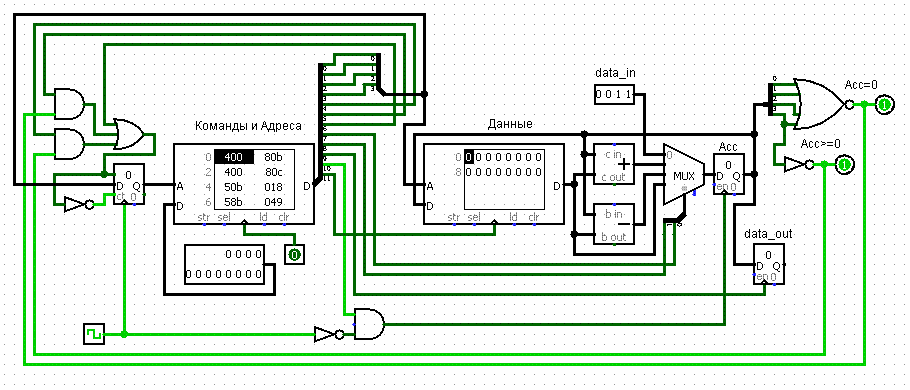 Part IPart IIPart IIIPart IVPart V
Part IPart IIPart IIIPart IVPart VLet's design
Little Man Computer in the Verilog language.
The article about LMC was on Habré.
Online simulator of this computer is
here .
We write the RAM / RAM module consisting of four (N = 2) four-bit (M = 4) words. Data is loaded into
RAM from
data_in at
adr when you click the button.
module R0 #(parameter N = 2, M = 4) ( input RAM_button, // input [N-1:0] adr, // input [M-1:0] data_in, // output [M-1:0] RAM_out // ); reg [M-1:0] mem [2**N-1:0]; // mem always @(posedge RAM_button) // mem [adr] <= data_in; // data_in assign RAM_out = mem[adr]; // RAM_out endmodule
As an external generator, we will connect
a 555 CMOS
timer (running from 3.3V).
We connect the
timer 555 to the counter, we connect the counter to the address input of the
RAM .
module R1 #(parameter N = 2, M = 4) ( input timer555, RAM_button, //input [N-1:0] adr, input [M-1:0] data_in, output [M-1:0] RAM_out ); reg [1:0]counter; // always @(posedge timer555) // counter <= counter + 1; // 1 wire [N-1:0] adr; assign adr = counter; // reg [M-1:0] mem [2**N-1:0]; always @(posedge RAM_button) mem [adr] <= data_in; assign RAM_out = mem[adr]; endmodule
Add a load function to the counter.
Loading is done with the
Counter_load command.
//input Counter_load; wire [3:0] branch_adr; // assign branch_adr = data_in; always @(posedge timer555) begin if(Counter_load) // "Counter_load" "branch_adr" counter <= branch_adr; else counter <= counter + 1; end
In a separate module, create a 4bit register (battery).
module register4 ( input [3:0] reg_data, input reg_button, output reg [3:0] q ); always @(posedge reg_button) q <= reg_data; endmodule
Add to the general scheme
Acc battery,
MUX2 multiplexer and
sum adder.
The adder adds to the number in the battery
Acc numbers from the memory.
The
data inputs of the multiplexer are served by the
data_in and
sum numbers.
Then the number from the multiplexer
MUX2 is loaded into the battery
Acc .
module R2 #(parameter ADDR_WIDTH = 2, DATA_WIDTH = 4) ( input timer555, Counter_load, RAM_button, input MUX_switch, input Acc_button, input [3:0] data_in, output [3:0] Acc, output [DATA_WIDTH-1:0] RAM, output reg [1:0] counter ); wire [1:0] branch_adr; assign branch_adr = data_in[1:0]; //Counter always @(posedge timer555) begin if(Counter_load) counter <= branch_adr; else counter <= counter + 1; end wire [ADDR_WIDTH-1:0] adr; assign adr = counter; //RAM reg [DATA_WIDTH-1:0] mem [2**ADDR_WIDTH-1:0]; always @(posedge RAM_button) mem [adr] <= Acc; assign RAM = mem[adr]; //sum wire [3:0] sum; assign sum = Acc + RAM; //MUX reg [3:0] MUX2; always @* MUX2 = MUX_switch ? sum : data_in; //Accumulator register4 Acc_reg( .reg_data(MUX2), .reg_clk(Acc_button), .q(Acc) ); endmodule

Add an element to the main module that subtracts the numbers stored in the memory from the number in the battery.
wire [3:0] subtract; assign subract = Acc - RAM ;
Replace the two-input multiplexer with a four-input multiplexer.
always @* MUX4 = MUX_switch[1] ? (MUX_switch[0] ? RAM : subtract) : (MUX_switch[0] ? sum : data_in);
Connect the output device to the battery (4bit register), also connect 2 flags to the battery:
1. The "Zero" flag is a log. element 4ILE or NOT. The flag is raised if the contents of the
ass is zero.
2. The “Zero or Positive Number” flag is a log. the item is NOT on the high-order discharge of the four-digit battery. The flag is raised if the contents of the
Ass is greater than or equal to zero.
// "" output Z_flag; assign Z_flag = ~(|Acc); // // " " output PZ_flag; assign PZ_flag = ~Acc[3];

Add three teams
1. loading the contents of the battery to the
data_out output
device2. loading the address into the counter if the zero flag is raised (
JMP if
Acc = 0)
3. loading the address into the counter, if the “zero or positive number” flag is raised (
JMP if
Acc > = 0)
module R3 #(parameter ADDR_WIDTH = 2, DATA_WIDTH = 4) ( input timer555, RAM_button, input JMP, Z_JMP, PZ_JMP, input [1:0] MUX_switch, input Acc_button, input Output_button, input [3:0] data_in, output [3:0] Acc, output [3:0] data_out, output [DATA_WIDTH-1:0] RAM, output Z_flag, PZ_flag, output reg [1:0] counter ); wire [1:0] branch_adr; assign branch_adr = data_in[1:0]; wire Z,PZ; assign Z = Z_flag & Z_JMP; assign PZ = PZ_flag & PZ_JMP; //Counter always @(posedge timer555) begin if(JMP|Z|PZ) counter <= branch_adr; else counter <= counter + 1; end wire [ADDR_WIDTH-1:0] adr; assign adr = counter; //RAM reg [DATA_WIDTH-1:0] mem [2**ADDR_WIDTH-1:0]; always @(posedge RAM_button) mem [adr] <= Acc; assign RAM = mem[adr]; //sum wire [3:0] sum; assign sum = Acc + RAM; //subtract wire [3:0] subtract; assign subtract = Acc - RAM; //MUX reg [3:0] MUX4; always @* MUX4 = MUX_switch[1] ? (MUX_switch[0] ? RAM : subtract) : (MUX_switch[0] ? sum : data_in); register4 Acc_reg( .reg_data(MUX4), .reg_clk(Acc_button), .q(Acc) ); register4 Output_reg( .reg_data(Acc), .reg_clk(Output_button), .q(data_out) ); assign Z_flag = ~(|Acc); assign PZ_flag = ~Acc[3]; endmodule

Put the commands and addresses in one RAM / RAM, and the data - in another.

The scheme can be downloaded
from here .
Commands are stored in the first eight digits, the address loaded into the counter is stored in the last four digits.
I note that the loading of the number into the accumulator
Ass should be done after switching the multiplexer
MUX (for commands
ADD ,
SUB ,
LDA ), according to the decay of the clock signal.
So in our computer the next command system
48x - add add number from ram to ass
50x - sub subtract the number stored in RAM from Ass
80x - STA save number from battery Ass to RAM at address x
58x - LDA load the number from address x to Ass
04x - BRA unconditional transition to the cell with the address x
02x - BRZ transition to the cell with the address x, if Ass = 0 (conditional transition)
01x - BRP transition to the cell with the address x, if Ass> = 0 (conditional transition)
40x - INP load a number from data_input to Ass
20x - OUT download the number from Ass to data_out
We will not have
HLT teams.
Take for example the algorithm for finding the maximum of two numbers from
http://peterhigginson.co.uk/LMC/The algorithm works like this: save two numbers from data_in to the data memory. Subtract the first from the second number:
- if the result is negative, write the first number in Ass, write in the data_out the number from Ass;
- if the result is positive, write the second number in Ass, write in the data_out number from Ass.
00 INP
01 STA 11
02 INP
03 STA 12
04 SUB 11
05 BRP 08
06 LDA 11
07 BRA 09
08 LDA 12
09 OUT
In our command system, this algorithm will look like this.
400
80b
400
80c
50b
018
58b
049
58c
200

The element
NOT on the control input of the counter, which is necessary for loading data into the counter, is such a feature of the Logisim program;
Quartus II can be downloaded from the official
site .
When registering in the My Primary Job Function is * section, select Student.
Next, you need to download the driver for the programmer (the driver for usb-blaster can be installed from C: \ altera \ ... \ quartus \ drivers \ usb-blaster).
Logisim can be downloaded
here .